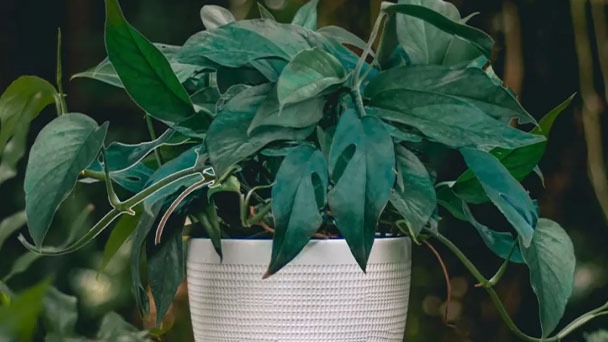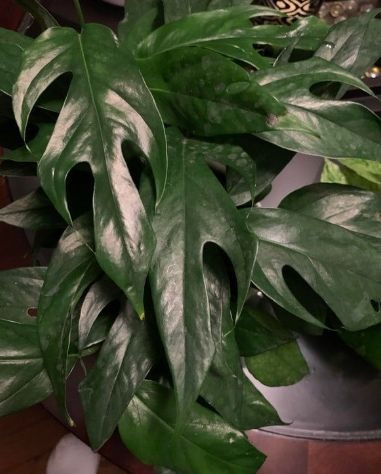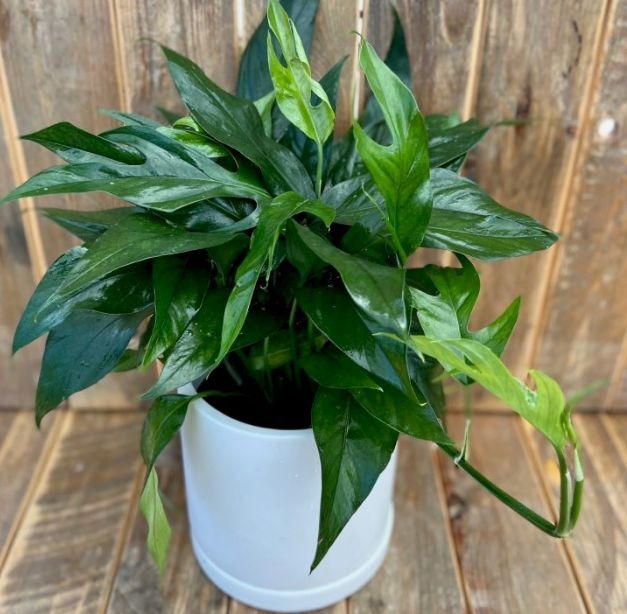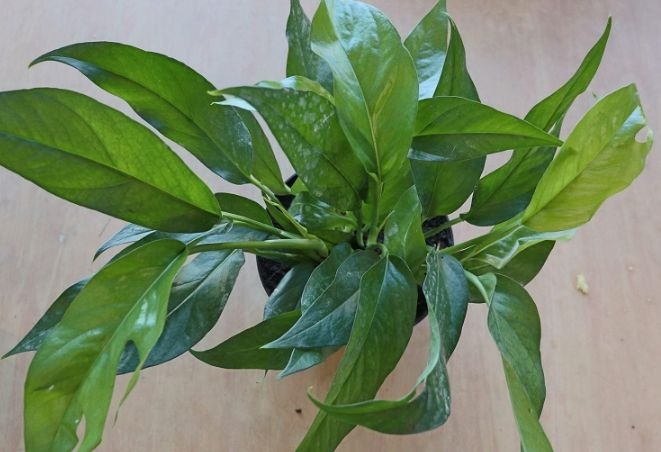Baltic Blue Pothos Care & Propagation Guide
Written by Ivy
Jan 20 2023

A little more color can be added to your indoor garden with the Baltic Blue pothos, which has stunning bluish foliage and roughly the same growing requirements as other pothos varieties.
To help your Baltic blue pothos grow to its full potential, read on to learn more about the growing conditions needed.
What is Baltic Blue Pothos?
Similar to other pothos, the Baltic Blue pothos (Epipremnum pinnatum 'Baltic Blue') is a tropical climbing or trailing vine that is indigenous to northern Australia, Malaysia, Indochina, and the southern regions of Japan, China, and Taiwan.
The Baltic Blue pothos is frequently grown indoors as a houseplant in the United States.
What Color is Baltic Blue?
As the plant matures, the Baltic Blue pothos's rich, deep green foliage begins to take on a bluish tint. Fall and winter are the seasons when this blue color is more noticeable. The Baltic Blue Pothos will also develop fenestration, which refers to split and holey leaves.
The Baltic Blue pothos has stunning foliage with a blue tint, which sets it apart from other Epipremnum pinnatum in appearance.
Is Baltic Blue Pothos Variegated?
While Albo Variegata, a cultivar of the pothos that resembles the Baltic Blue in appearance, has variegation, the pothos itself does not. Your Baltic Blue pothos may be suffering from a fungal infection or nutrient deficiency if it begins to show yellow streaks that resemble variegation.
Make sure not to overwater your pothos as this can result in a number of fungal issues and cause the leaves to turn a variegated shade of brown. To further lower the likelihood of nutrient deficiency, think about fertilizing the pothos during its active growing season.
What is the Baltic Blue Pothos' Origin?
A relatively new cultivar of pothos, the Baltic Blue pothos, was only found in 2022 by Costa Farms. Experts surmise that it resulted from a mutation in the Epipremnum pinnatum, whose once-dark green leaves began to turn blue.
Despite being a new variety, it quickly gained popularity among gardeners who want to incorporate this new cultivar. Since they will share the majority, if not all, of the same growing requirements as other varieties of pothos, adding the Baltic Blue should be fairly simple.

How Do You Take Care of Baltic Blue Pothos?
Although the Baltic Blue pothos isn't a particularly challenging plant to take care of, there are a few requirements that will help the plant stay strong and healthy. It thrives in direct, bright sunlight, constant warmth, higher humidity levels, and arid climates.
Light
When in indirect but bright light, the Baltic Blue pothos grows at its best. Having said that, despite its growth possibly being a little slow, this plant can tolerate low light conditions. Avoid placing this plant in direct sunlight as it may result in the leaves losing their bluish tint and discoloring.
About 3 feet away from an east- or south-facing window is the ideal indoor location for Baltic Blue Pothos. Use a sheer curtain or blinds to diffuse the direct light coming in from the window. The pothos can also be grown with artificial lighting as long as it is indirect.
Temperatures
All year round, Baltic blue pothos require warm temperatures. It prefers a temperature between 65 and 85 degrees Fahrenheit. Anything at or below 55 degrees will result in the plant's growth being stunted, shock, and eventually death.
The Baltic Blue pothos is a common indoor houseplant. The plant can be grown outside, though, if you live in a USDA Plant Hardiness Zone 10 or higher. On warm summer days, even if you reside outside of these zones, you can still move the potted pothos outside.
Do not forget to keep the Baltic Blue pothos away from any areas of your home where there may be sharp and sudden temperature changes. These places include those near drafty windows and doors or those close to heating and cooling vents.
Watering
Depending on the age and size of the plant, as well as the temperature, humidity level, and season, the plant will require a different amount of water.
Prior to watering your pothos, wait until the top 2 inches of soil feel dry. When watering is necessary, use the soak and drain technique, which involves slowly adding water to the pot until the extra water drains out of the holes at the bottom of the pot.
How frequently your Baltic Blue needs to be watered will depend on the type of pot you choose. It requires less watering to maintain plastic pots because they typically retain more moisture. On the other hand, clay and terracotta pots are porous materials that absorb water, requiring more frequent watering of the plants.
While some gardeners think there's nothing wrong with using tap water, others prefer to give their plants distilled, spring, or rainwater. If you do choose to use tap water, you might think about letting it sit for 24 hours before using it to water the pothos. The chlorine that is added to tap water will have ample time to evaporate thanks to this.
Soil
A soil that is nutrient-rich and has good drainage is ideal for growing Baltic Blue pothos. The best soil will retain moisture while allowing water to drain quickly. Equivalent amounts of potting soil, pumice or perlite, and orchid bark make up a good general soil mixture for pothos.
While a wide variety of commercially available soils are suitable for Baltic Blue pothos, you might want to think about making your own using the three items mentioned above. To enhance the soil's nutrient content, you can also add some organic compost.
Humidity Levels
Although they don't have a lot of humidity preferences, they do grow best at humidity levels between 50 and 60 percent. Large leaves and rapid growth are encouraged by the air's relative humidity.
The most common way to raise the humidity level around your pothos plant is to use a drip tray. The potted plant is placed on top of shallow, pebble-filled containers called drip trays. When you water the plant, extra water drips into the drip tray from the pot.
The humidity level around the pothos will rise as a result of the water in the drip tray evaporating into the atmosphere naturally. Use of a humidifier is another choice.
Fertilizing
From spring to fall, feed the Baltic Blue pothos once a month. This is the time when the plant is actively growing. Use a liquid fertilizer that is all-purpose and has been diluted to half its strength.
Keep in mind that you shouldn't fertilize your pothos during the winter because this is when it is dormant, and you don't want to promote growth at this time. Additionally, make sure to adhere to the application instructions and warnings listed on the fertilizer bottle and never apply more than the recommended dosage.
Pruning
Due to the fast growth rate of the Baltic Blue pothos, you might need to prune it more frequently than your other houseplants in order to keep its size and shape under control. Another thing to keep in mind is that this plant occasionally becomes leggy; therefore, pruning your pothos will aid in reducing legginess and promote the growth of foliage.
When pruning any plant, always use a pair of sharp, clean shears. Don't forget to wash and sanitize the shears after each use as well. This aids in limiting the spread of diseases from one plant to another.
Repotting
The Baltic Blue pothos may need to have its pot replaced every two to three years if it outgrows it. Even though this plant doesn't mind a little root encumbrance, not enough room for the roots will result in slow growth and ill health. Observing roots emerging from the drainage holes on your pothos is a sure sign that it needs to be repotted.
Repot the plant whenever the time comes, but use a container that is about 2 inches wider than the old one. Repotting should ideally be postponed until the plant's active growing season.
Repotting a pothos plant can sometimes be a necessary step in the growth process, but it can also be hard on the plant. To increase the likelihood that the Baltic Blue pothos will recover quickly, wait until it is actively growing.
Maintenance
Every month to month and a half, give your pothos a shower to help wash away the dust that can accumulate on the plant's leaves naturally. Regular showers can also help repel sap-sucking insects like spider mites and can even wash excess minerals and salts out of the soil.
It is sufficient to place the plant under the shower for a few minutes before letting the water drain from the pot.
Is Baltic Blue Rare?
The Baltic Blue pothos is not regarded as a rare plant and can be bought at almost any store that sells Costa Farms plants. The Baltic Blue pothos can be ordered directly from the Costa Farms website if you can't find it in your neighborhood nursery or garden center.
Despite the fact that this plant is relatively new, it has already started to appear in a wide variety of shops. Although buying plants locally is almost always the best choice, you can also purchase Baltic Blue pothos online from the company that created this variety as well as from other people who have grown their plants from cuttings.
Where to Find a Baltic Blue Pothos for Sale
If you want to purchase a Baltic Blue pothos, start by looking locally. They might be available in the garden centers of a few big box stores, like Walmart, and in the not too distant future, even your neighborhood nursery might stock them. The Costa Farms website or Etsy both accept online orders for them.
Remember that you might have to pay for shipping if you order the plant online, which will significantly raise the pothos' overall cost.
If the Baltic Blue pothos isn't in stock where you are and you don't want to order it online, ask your neighborhood garden center if they can order it for you. Customers can occasionally add extra items to their regular orders without having to pay shipping costs.

How to Repot Baltic Blue Pathos?
Repotting is a good way to increase your plant's health and make sure it's receiving the proper amount of water and nutrients. Check for over- or under-watering in your Baltic Blue Pothos as you would with any other indoor plant. Overwatering is probably the cause of the plant's yellowing and drooping leaves on one side. However, if the edges start to turn brown and crispy, it might be dehydrated.
When your plant's roots have completely occupied the pot it is currently housed in, which you can determine by lightly pressing on the soil, is the ideal time to repot it. Don't worry if you notice roots poking through drainage holes at any point during this process; they will adjust! Just be careful not to let too much water enter those holes, as rot could quickly develop if it does.
In addition, if your pot begins to look worn or dirty, you should think about replacing it every few years. This is crucial if you intend to keep your plant indoors all year long as opposed to only bringing it outside in the summer, as most experts advise. When choosing what might work best, keep in mind that they require a lot of light but only a small amount of water. As a result, choose something with good drainage holes rather than items made of plastic, which have a tendency to retain moisture for an excessively long time.
How to Propagate Baltic Blue Pothos
By taking 3 to 5 inch stem cuttings from the plant, Baltic Blue pothos are propagated. Remove the bottom leaves after making sure the stem has a few leaf nodes. After about 4 weeks of rooting the cutting in either soil or water, roots should start to form.
Place the pothos cutting where it will receive bright, indirect light if you're potting it up in soil. After that, take care of the young plant as you would the parent plant. However, if you are rooting the cutting in water, you will need to change the water once every seven days.
The cut end of the stem can be dipped in rooting hormone to hasten the rooting process. If you are rooting the cutting in water, you must plant it in the ground once the roots reach a length of a few inches.
How to Prune Baltic Blue Pothos?
Your Baltic Blue Pothos' size can be effectively managed by pruning. Pruning may be necessary if you notice that your plant is becoming lanky. Once a year, between March and May, you should prune your plants by removing an inch or two (2–5 cm) of stem near each leaf node while leaving the bottom three nodes uncut. Make sure you don't cut any green growth because doing so will hasten the aging of the leaves and possibly result in plant death.
If you have over-pruned, you will notice bare stems that are visible between leaves where new branches once sprouted from.
Does Baltic Blue Climb?
Since Baltic Blue Pothos is a naturally vining or climbing plant, you can grow it up a pole, wall, trellis, or other structure. Many people choose to use a moss pole for this. It does, however, also flourish when trailing from a planter or a hanging basket.
Keep in mind that growing a Baltic Blue pothos climbing a wall or other structure may result in the plant having smaller leaves than if it were grown in a basket or planter.
Does Baltic Blue Pothos Grow Fast?
Especially when compared to variegated varieties, the Baltic Blue pothos grows fairly quickly. Because the white or light colored areas of the plant have less chlorophyll, variegated varieties grow slowly. Because they are entirely green or green in color, pothos with no variegation, like the Baltic Blue pothos, grow much more quickly.
You might need to prune the Baltic Blue pothos more frequently than some other pothos varieties because it grows quickly. In order for the plant to fit within the confines of its growing space, pruning aids in maintaining the plant's size.
Any healthy stem that is removed from the plant during pruning can be used as a cutting. Why throw away a perfectly good piece of your Baltic Blue pothos when you can make it into its own plant, after all?
How Big Does a Baltic Blue Pothos Get?
If given their ideal growing conditions, Baltic Blue pothos can reach heights of 4 to 6 feet. Lack of proper care has an impact on the plant's general health, which has an impact on how big the plant can grow.
The Baltic Blue pothos can be controlled in size with the help of pruning. Determine the height of the pothos before beginning to prune, then cut the stems at that height. A leaf node should be just above where the stem is cut.
Examine the plant's current care if your Baltic Blue pothos isn't developing as you would like. You are preventing a plant's growth if you do not give it the best conditions for growth. However, if the pothos has been receiving all the care it requires to stay healthy, you might think about fertilizing it to promote growth.
Are Baltic Blue Pothos Toxic to Cats?
For cats, dogs, and even humans, all pothos are listed as being toxic. Pothos contains the poisonous calcium oxalate crystals, which, when consumed, can result in excessive drooling, difficulty breathing, vomiting, and nausea in addition to mouth and throat swelling.
It is best to keep this plant out of the reach of kids and animals because it presents a risk. Consider a safer and non-toxic species of houseplant if you're unsure you can keep your children and pets away from the pothos.
If you think your cat may have eaten any Baltic Blue pothos, get medical help right away or call poison control. While the majority of cats will bounce back, extreme circumstances could pose a grave and even fatal threat to your cat's life.
Why is My Baltic Blue Pothos Not Fenestrating?
Once the Baltic blue pothos plant reaches maturity, the leaves will begin to split. It's possible that your plant is still too young if it lacks fenestration. Provide the plant with something to climb if you know it has reached maturity but is still not producing split leaves.
The Baltic Blue pothos should be permitted to climb a moss pole in order to promote large leaf splits, according to experts. If you can't or don't want the Baltic Blue pothos to trail, it won't likely develop fenestration or, if it does, it won't have noticeable splits.
Keep in mind that the Baltic Blue pothos can be a beautiful and healthy plant even without developing fenestration. There may not necessarily be a problem with the plant if the leaves are not split.

How to Identify If Your Plant is Sick?
You might observe a few typical symptoms if your Baltic Blue Pothos plant is ill.
Yellowing leaves are one of the most typical indications that a Baltic Blue Pothos plant is ill. When the leaves on your pothos begin to yellow, you should remove and discard them right away. By doing this, you can prevent infection from spreading to the rest of your plant and causing its death.
Brown spots on the tips of your Baltic Blue Pothos' leaves could mean that it is either receiving too much water or not enough light. Moving your plant to a more sunny spot or giving it less frequent but deeper waterings can both help with this issue.
Wilting leaves are another sign that your plant is ill. If this occurs, be sure to check the soil as there may be too much water in it causing root rot or a lack of oxygen due to over-fertilizing with nitrogen-rich fertilizer products like blood meal or bone meal which prevent root growth by blocking nitrogen uptake by plants roots through the formation of insoluble salts at their surfaces preventing root growth.
Common Problems
Why Are My Baltic Blue Pothos Leaves Turning Yellow?
While there are a number of potential causes for your Baltic Blue pothos' yellowing leaves, either excessive watering or poor soil quality is the most typical culprit. Both of these have the potential to result in leaf discoloration, which is frequently the first indication that root rot is beginning to develop and may be fatal for your plant.
The first step in stopping your pothos's leaves from turning yellow is to ensure that they are growing in well-draining soil and in containers with drainage holes at the bottom. (Read More: How to Choose The Best Pot For a Pothos Plant)
In addition, you should only water the plant when the top two inches of soil are dry. This will help greatly in avoiding overwatering and guard the Baltic Blue pothos against fungi that could cause diseases like root rot in your pothos, which could potentially kill the plant.
Why Does My Baltic Blue Pothos Have Brown Spots?
When brown spots start to appear on your Baltic Blue pothos, there is no doubt that the plant is not receiving enough humidity or water. Crispy and curled leaves, extremely dry soil, and wilting are additional signs that the brown spots may be present. (Read More: Why Are My Pothos Leaves Curling)
Fortunately, you can usually fix the issue by deeply watering the plant whenever the top 2 inches of soil become dry and raising the humidity levels. A quick and simple way to naturally raise humidity is to place the plant on a drip tray.
Inadequate watering or high humidity levels are the two most frequent causes of brown spots on pothos, but bacterial or fungal diseases can also be to blame. If the spots only affect a few leaves, you can stop the disease from spreading by simply chopping off the affected leaves. However, the only option is to dispose of the plant if the majority of it is covered in these spots.
FAQs
Is Epipremnum Pinnatum Baltic Blue Toxic?
The ASPCA omits Epipremnum pinnatum in its list of plants that are toxic to cats and dogs. But poisonous calcium oxalate crystals are present in all pothos (Epipremnum) species.
Ingestion results in swelling of the mouth and throat, wheezing, nausea, and vomiting. Always keep Baltic Blue Pothos away from pets to avoid mishaps.
How Big Does a Baltic Blue Plant Get?
The Baltic Blue Pothos has a maximum height of 6 feet (1.8 meters). With the proper growing conditions, its rapid growth rate can enable it to reach that size in less than three years.
Are Blue Pothos Plants Rare?
The Baltic Blue Pothos is a new cultivar of the Epipremnum pinnatum. Although it is less common than Golden Pothos, it is not so uncommon that only ardent collectors can obtain it.
This cultivar was first made available by Costa Farms in early 2022, and it is now widely available in stores and online.
In online communities for houseplants, you can also find people offering cuttings for sale at reasonable prices.
Is There a Variegated Baltic Blue Pothos?
There isn't a variation-containing official version. A nutrient shortage or a fungus problem may be to blame if you see faint yellow streaks on the leaves of your Blue Pothos plant.
If you're after a similar plant with variegation, look for the Epipremnum pinnatum Albo Variegata cultivar.
Does a Baltic Blue Climb?
This pothos can be grown as a climbing or trailing plant. The leaves will get smaller over time if you keep it as a trailing plant in a hanging basket or a wall planter.
But if you give it something to climb, like a totem, a trellis, or even better, a moss pole, the plant will grow bigger leaves with clearly defined fenestrations.
Is Baltic Blue Pothos the Same as Cebu Blue?
Baltic Blue and Cebu Blue pothos are cultivars of the same species (Epipremnum pinnatum) but are different plants. The main variations between them are the growth and color of the leaves.
Cebu Blue leaves are a silvery blue color, while Baltic Blue leaves are a deeper, blue-green hue. Furthermore, Baltic Blue Pothos leaves will fenestrate earlier than Cebu Blue.
Conclusion
In conclusion, Baltic Pothos should be watered in indirect sunlight for the best results. During its growing season, a pot of any size requires more water. I hope this article piqued your curiosity about the baltic blue pothos plant.
Latest Updated
- Benefits of Bugleweed - 7 Science-backed Health Benefits
- Bugleweed Dangers & Side Effects - Is It Poisonous?
- How to Plant Evergreen Trees - What You Should Know
- When to Plant Evergreens - Grow Guide for Evergreen Trees
- 12 Wonderful Evergreen Shrubs for Your Garden
- 12 Popular Evergreen Plants with Pictures for Beginners
- When And How To Prune A Lilac Bush Like a Pro
- How to Grow & Care for Lilac Vine (Hardenbergia Violacea)
- Japanese Lilac Tree (Syringa Reticulata) Care & Propagation Guide
- Shumard Oak Pros and Cons - What to Know
Popular Articles
- Winter maintenance of Antirrhinum Majus
- How to Grow Terminalia Mantaly Tree
- How to Grow and Care for Crossostephium Chinense
- How to grow Antirrhinum Majus in spring
- Peristeria Elata (Dove Orchid) Profile: Info & Care Guide
- Underwatered Snake Plant (Sansevieria Trifasciata) - Signs And How To Fix
- How to Care for Brazilian Jasmine Plant (Mandevilla Sanderi)
- How to Grow & Care for Graptopetalum Purple Delight in Summer
- Rosa Chinensis (China Rose): Plant Growing & Care Tips
- How to Care for Baby Sun Rose (Aptenia Cordifolia)